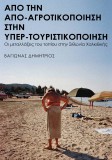The research examines the spatial-social dynamics of tourism in the context of parallel processes of de-urbanization and hyper-tourism where local economies, social relations and their architectural and spatial expressions are defined and/or related exclusively to tourism. The area of analysis is Sithonia Halkidiki and more specifically Vourvourou, where within a few decades intense changes in the landscape, in the relations of the local population with the land and in the architectural typology have been observed. The paper traces these changes from the 70’s and 80’s when mainly Germans, Austrians and Italians were the first visitors to the area until today when the area is now living and breathing on the basis of tourism with a developed tourism industry, able to accommodate and serve thousands of people every summer coming mainly from neighbouring Balkan countries.The main tools of analysis are the creation and study of maps, the historical record of the shift from agriculture to tourism through personal testimonies, family records, and field observation, as well as the critical analysis of the ways in which architecture has contributed to the general transformation of rural settlements into tourist destinations: from rooms for rent to large ‘all-inclusive’ hotels. The main question of the research paper is how a place is structurally affected when a one-dimensional form of economy dominates it not through external imposition but through an organic development and internal dynamics of its societies.
